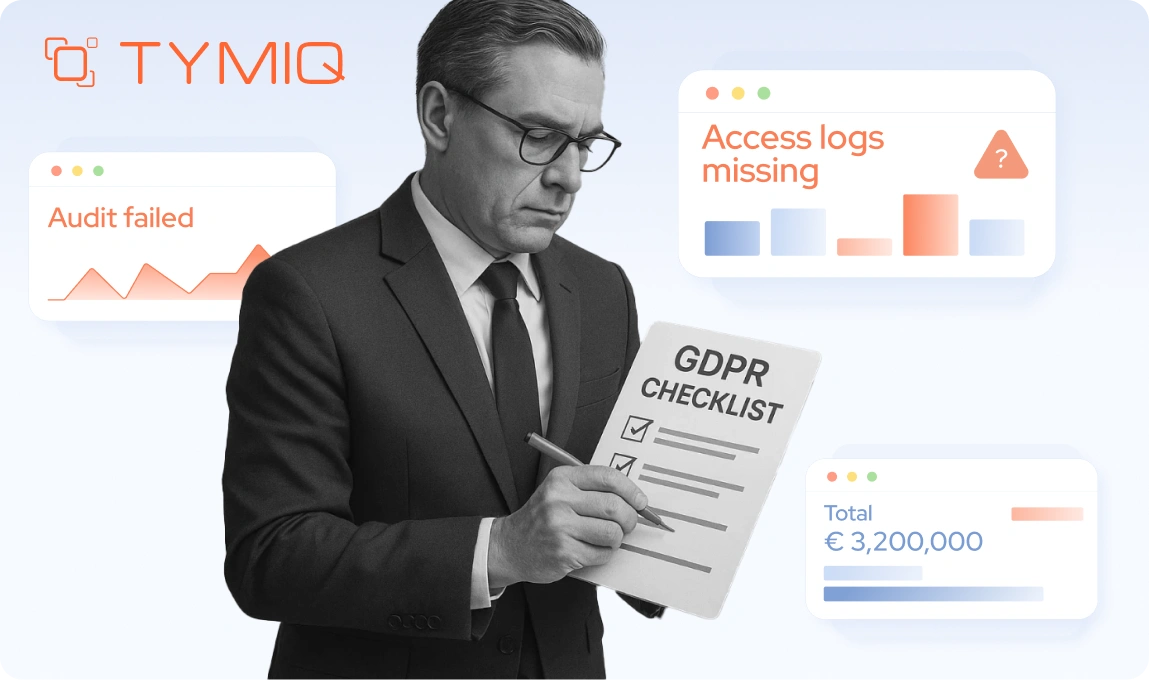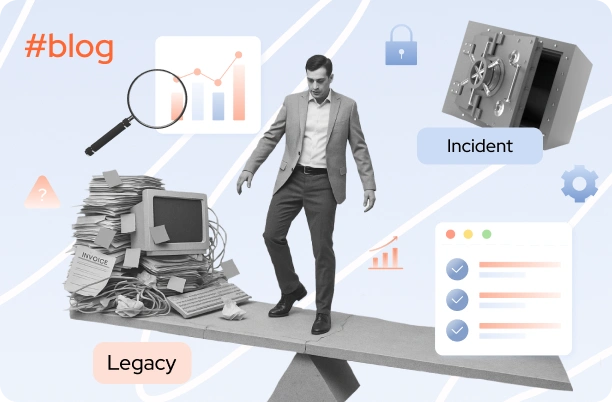Think of this as the companion to your “cost of doing nothing” brief. Last time, we tallied the drain. Now, we make the call on when to act and what action will actually be demanded.
We define cost broadly: not only dollars, but human energy, cognitive load, and time-to-value. Modernization changes all four. You recover cash, you return focus, you reduce mental overhead, and you shorten the path from idea to impact.
Some signals will look familiar. That is the point. The same red flags that drain you today are exactly what modernization fixes: outages, scarce skills, brittle integrations, and clunky experience. We move in escalation, not resets: from hard dollars to soft friction to opportunity loss, then to the competitive gap those losses create.
What you will get here: 14 clear signs, each with why it matters, cost to act, and cost to wait. Where relevant, we note parallel migration (keep service live while you modernize) so you do not trade risk for progress.
Read this as a practical guide. If a sign matches your reality, score it and keep moving. By the end, you will know whether to plan, pilot, or proceed, and you will know the price of each path.
Sign 1. Frequent downtime and system instability

Why it matters
Legacy platforms without redundancy or failover do not just pause - they stop. Across the Global 2000, unplanned downtime drains about $400 billion annually, with individual firms losing roughly $200 million each year. And the pain accelerates with frequency: 91% of enterprises face hourly downtime costs over $300,000, and organizations with recurring outages pay 16× more than resilient peers.
Cost to act
Planned migration to a resilient, cloud-based architecture with built-in redundancy and failover. Designed for 24/7 availability, including during releases, so updates stop colliding with uptime.
Cost to wait
SLA penalties. Weekend “war rooms” that pull senior staff from strategic work. Lost revenue and productivity from each outage hour — compounded if recovery requires rare, premium-rate skills. Every month you delay, you extend the parallel-run period needed to migrate safely.
Sign 2. Inability to scale with business growth
Why it matters
Monolithic systems strain under rising transactions or data loads. As usage spikes during peak seasons, product launches, or rapid customer acquisition, performance falters. Scaling up becomes a project, not a setting, which caps your ability to capture demand when it is hottest.
Cost to act
Move to elastic, cloud-native infrastructure that scales automatically with demand. The investment delivers headroom for traffic surges, data growth, and new service rollouts without architecture rework.
Cost to wait
Delayed launches into growth markets. Missed seasonal peaks when systems choke under load. Lost credibility with partners and customers when performance lags, exactly when interest is highest. Over time, the growth ceiling becomes visible to your competitors, as well.
Sign 3. High security vulnerabilities

Why it matters
End-of-support software stops receiving security patches, leaving permanent holes. Legacy systems are three times more likely to suffer cyberattacks than modern stacks, and in financial services, the average breach costs $6.08 million . In 2025, Gartner states, companies spend 40% of IT budgets are servicing technical debt, much of it tied to closing security gaps.
Cost to act
Rebuild with a secure-by-design approach: modern encryption, zero-trust architecture, and continuous monitoring. This shifts security from reactive patching to proactive prevention.
Cost to wait
Breach costs in the millions, regulatory fines, and erosion of customer trust that takes years to rebuild. Each quarter you delay, the risk compounds, and the next patch you need might never come.
Sign 4. Difficulty attracting and retaining talent
Why it matters
Top engineers avoid outdated tech stacks, and those who can work on them are becoming scarce. 58% of senior developers at medium-to-large companies are considering quitting because of legacy technology, and 86% say they feel embarrassed by their stack. Another 74% report their tech stack shapes their professional identity, meaning your tools influence whether they stay. When key specialists leave, they take irreplaceable institutional knowledge with them.
Cost to act
Modern frameworks, cloud-native platforms, and current development practices attract top talent and cut onboarding times. Teams move faster, morale improves, and recruitment cycles shorten.
Cost to wait
Longer hiring timelines, higher contractor rates for rare skills, and rising churn among frustrated staff. Knowledge drains with every exit, and the fewer experts remain, the higher your exposure during incidents or migrations.
Sign 5. Poor user experience
Why it matters
Slow, clunky, and non-mobile interfaces frustrate both customers and employees. 91% of employees report frustration from inadequate workplace technology. This is a drag on engagement, productivity, and retention. For customers, friction at checkout, onboarding, or daily use erodes satisfaction and accelerates churn.
Cost to act
Deliver a responsive, intuitive UI/UX designed for all devices. Modern interfaces reduce task times, cut training needs, and create a smoother experience that drives repeat use and loyalty.
Cost to wait
Higher churn rates, lower satisfaction scores, disengaged teams, and a widening gap between you and competitors delivering seamless, mobile-first interactions. Every day of poor UX is a day your audience tests alternatives.
Sign 6. Incompatibility with modern tools and platforms
Why it matters
Legacy systems often lack APIs or integration layers, forcing brittle, manual workarounds. In financial services, organizations run an average of 897 applications, yet only 28% are integrated, which slows automation, analytics, and cross-platform workflows. Without easy integration, every new tool or partner requires custom effort, delaying adoption and increasing costs.
Cost to act
Adopt an API-first architecture that enables fast, standardized connections to SaaS products, partner platforms, and analytics tools. This accelerates automation and unlocks new capabilities without disrupting core operations.
Cost to wait
Missed opportunities to automate workflows, delayed partner onboarding, and blocked access to real-time insights. Competitors with integration-ready stacks will connect faster, experiment more, and respond sooner to market shifts.
Sign 7. Regulatory non-compliance risks

Why it matters
Legacy systems often require manual workarounds to meet compliance standards, creating audit exposure. Without automated controls, outdated platforms struggle to align with evolving regulations like GDPR, PCI-DSS, and NIST. Each gap increases the risk of audit failures, financial penalties, and reputational damage, especially in industries with strict oversight such as finance, healthcare, and aviation.
Cost to act
Implement systems that embed compliance by design, with audit trails, access controls, and reporting capabilities that meet current and foreseeable standards out of the box.
Cost to wait
Fines that can reach millions, protracted remediation projects, and public trust erosion. In regulated industries, even a single compliance failure can halt operations until issues are resolved, often at peak cost and urgency.
Sign 8. Escalating maintenance costs
Why it matters
Keeping legacy systems running consumes a disproportionate share of IT budgets. In banking, 70% of IT spend goes to maintenance. Across industries, maintaining a single legacy system costs about $30 million over its life, and collectively, organizations spend more than $1.14 trillion annually on legacy upkeep. Nearly two-thirds of companies pay over $2 million per year just to keep outdated systems operational - with no added capability.
Cost to act
Modernized platforms shift spend from unpredictable maintenance spikes to predictable operating expenses, while reducing reliance on scarce and expensive skill sets.
Cost to wait
Annual cost creep of 10–15%, premium contractor rates, and infrastructure inefficiencies that stack year after year. Every renewal or “temporary” patch compounds the total without delivering new value.
Sign 9. Mounting technical debt

Why it matters
Patchwork fixes and outdated code create brittle dependencies that slow every project. Developers already spend 13.5 to 17.3 hours per week - roughly one-third to 42% of their time on legacy maintenance instead of new features. In the UK, 44% of teams spend 26–50% of their time on legacy systems, and 26% spend 50–75%. This drag raises defect rates, lengthens release cycles, and stalls innovation.
Cost to act
Rebuild or refactor into a clean, modular architecture. This reduces dependencies, accelerates delivery, and frees developer time for high-value work.
Cost to wait
Growing backlog, slower time-to-market, and higher defect counts. Each year of delay multiplies rework and raises the risk of outages or security incidents tied to fragile code.
Sign 10. Eroded business agility
Why it matters
When adding a new feature takes months instead of weeks, you lose ground to more nimble competitors. Technical debt and rigid architectures slow responsiveness to customer feedback, market changes, or regulatory demands. The result: missed windows to launch, pivot, or capitalize on emerging trends.
Cost to act
Implement continuous integration and continuous deployment (CI/CD) pipelines, supported by modern architectures that allow rapid iteration without disrupting operations.
Cost to wait
Delayed releases, slower responses to shifting customer needs, and lost opportunities in fast-moving markets. Competitors who can adapt quickly will capture attention and revenue before you can ship.
Sign 11. Vendor abandonment or M&A risk
Why it matters
When a vendor sunsets a product or changes pricing and support terms after a merger or acquisition, you can be forced into a rushed transition. Without a controlled modernization plan, you face uncertainty over maintenance, security patches, and licensing, and critical operations may be left unsupported.
Cost to act
Plan a phased modernization on your own timeline, replacing or reengineering systems before vendor actions disrupt your operations. This allows for testing, parallel runs, and risk mitigation.
Cost to wait
Emergency migrations at premium contractor rates, compressed timelines that increase error risk, and service interruptions that hurt customer trust. Vendor decisions made without your input can dictate your budget and priorities overnight.
Sign 12. Growing integration backlog
Why it matters
Legacy architectures make connecting to new partners, SaaS tools, or data sources slow and complex. As we said above, the average large organization runs 897 applications, yet only 28% are integrated, leaving hundreds of siloed systems. Each integration request joins a backlog that can stretch for months, blocking automation, analytics, and revenue opportunities.
Cost to act
Adopt an integration-ready, API-first architecture that supports multiple concurrent connections without heavy customization. This shrinks backlog, speeds partner onboarding, and enables faster experimentation.
Cost to wait
Lost deals when partners cannot connect quickly. Declining trust from collaborators who see you as slow to respond. Every month of backlog represents the value competitors can realize while you are still building connectors.
Sign 13. Data quality and accessibility issues

Why it matters
Fragmented, inconsistent, or outdated data undermines analytics, forecasting, and decision-making. Without a unified source of truth, teams waste hours reconciling reports, and leaders make calls based on incomplete or inaccurate information. Poor accessibility also limits cross-department collaboration and slows compliance reporting.
Cost to act
Implement a centralized, clean data model with governed access and real-time synchronization across systems. Modern data platforms enable faster reporting, more accurate forecasting, and informed strategic decisions.
Cost to wait
Operational blind spots, flawed business decisions, and slower reaction to market changes. Competitors with unified, accessible data will spot trends (and act on them) before you have the full picture.
Sign 14. Inflexible licensing or usage terms
Why it matters
Per-seat, capacity-based, or rigid licensing models often force you to pay for unused features and inactive accounts. Legacy vendors may bundle essential modules with unnecessary add-ons, locking you into multi-year contracts that do not match real usage. This misalignment drains budget and limits your ability to pivot.
Cost to act
Shift to usage-based SaaS pricing aligned with actual demand. Modern licensing models scale up or down as needs change, ensuring you pay only for what you use.
Cost to wait
Ongoing payments for “shelfware” and unused capacity. Inflexible terms can delay expansion into new markets or teams because licensing changes require renegotiation, not a configuration update. Over time, these contractual constraints add up to millions in wasted spend.
Approaches to modernization
Why this matters
Modernization is not one-size-fits-all. Choosing the wrong approach can either underdeliver (fixing surface issues but leaving core problems) or overextend (rebuilding when a simpler path would suffice). Matching strategy to urgency, complexity, and business priorities ensures you capture value without overinvesting.
Framing the decision
The signs you’ve identified in earlier sections will point to the right approach. For example:
- High downtime and integration backlog often point to re-engineering.
- Escalating costs without deep technical debt may be solved through re-hosting.
- Heavy maintenance and talent churn might be addressed by refactoring to modern standards.
Next steps
1. Run a modernization assessment
You can map every application, dependency, and compliance gap to see, in plain numbers, which systems create value, and which quietly drain it.
2. Secure stakeholder alignment
You might bring executives, IT, operations, and end-users into the same discussion, framing shared objectives, measurable KPIs, and timelines that make “someday” decisions harder to postpone.
3. Select the right strategy
You could let urgency and complexity guide the choice: re-hosting for quick scale, refactoring for steady gains, re-engineering for deep fixes, or package replacement when the market already offers a fit.
4. Adopt Agile and DevOps practices
Consider shifting to shorter, safer delivery cycles. Automated tests and continuous deployment can turn high-risk release days into quiet, background improvements.
5. Track key metrics
You may find that watching uptime rise, release cycles shorten, and defect rates drop makes it easier to justify (and finance) the next modernization phase.
Final thought
You can treat the red flags you see today as pressure to act before cost, risk, and delay start compounding faster than you can contain them. Each quarter you wait, the “do-nothing” bill grows (often invisibly) while competitors turn that same time into momentum.
Conclusion: Seeing the tipping point before it tips you
The pattern is rarely dramatic. It is a slow escalation: from hard costs you can point to on a budget line, to operational friction you feel every day, to opportunities you never even see because a competitor claimed them first. By the time the competitive gap is obvious on the balance sheet, the cost of catching up has doubled.
You might never have all 14 signs flashing at once, but a cluster of three or four is enough to start the clock. Each quarter you hold off, you are not just paying the “do-nothing” bill; you are funding someone else’s advantage. The systems will not change themselves, and the market will not slow down for you.











.svg)

